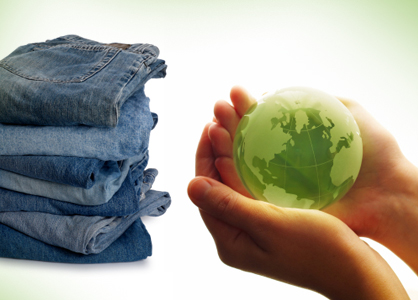New eco-friendly method to sandblast jeans
So pretty much every gal is a fan of blue denim jeans. Now you can also be a fan of how they are produced. A recent study, reported in Biotechnology Journal, made public a cheaper, easier and more environmentally sustainable method for treating dyed denim, reported Science Daily.
The traditional technique of sandblasting is so dangerous it is widely banned internationally. Now a technique, using “surface activation” to wash down denim after dyeing, could be its replacement.
“The global production of denim is estimated at 3 billion linear meters and more than 4 billion garments per year,” Thomas Bechtold, from the Research Institute for Textile Chemistry and Textile Physics at the University of Innsbruck, said to Science Daily. “To create blue jeans denim is dyed with indigo an organic compound which is estimated to be produced in quantities of over 30,000 tons per year.”
Sandblasting creates a worn or torn appearance, often popular with consumers. But the method can cause lung disease and is therefore banned – but not everywhere. A visit to denim workshops in Bangladesh, Egypt, China, Turkey, Brazil and Mexico would reveal that the process is still alive and well in many nations.
The dangers of sandblasting spurred Dr. Bechtold and his team to study alternatives, such as using chemicals to wash out the jeans.
“A central step in the processing of indigo dyed textiles such as blue jeans are the wash and bleach processes used to create a final wash down effect,” Bechtold said. “To remove the ring dyed indigo dyestuff manufactures use a combination of drum washing machines and chemical treatments.”
Chemicals such as Sodium Hypochlorite (NaOCl) are employed to lessen the amount of dyestuff. Its low cost and range of effects have led NaOCl to be used in 80 percent of jeans produced.
Since the treatment focuses on the outer layers of the jeans, the researchers explored surface activation techniques, which they hoped to reduce the amount of chemicals needed for faded results. These new methods proved to have many advantages: preventing the decease of fabric strength, shortening the duration of the wash-down process and reducing the concentrations of costly chemicals.
“This method also offers a replacement of the sandblasting of denim, which is an extremely unhealthy process for which, until now, there have been few alternatives available,” Bechtold maintained. “The surface activation method also allows for more eco-friendly processing of jeans in the garment industry, which is approximately 10 percent of the total cotton market worldwide.”
Tagged in: denim, jeans, environment, treatment, bechtold, dye, dyeing, sandblast, eco-friendly,

Purple Neon/LadyLUX via istock



